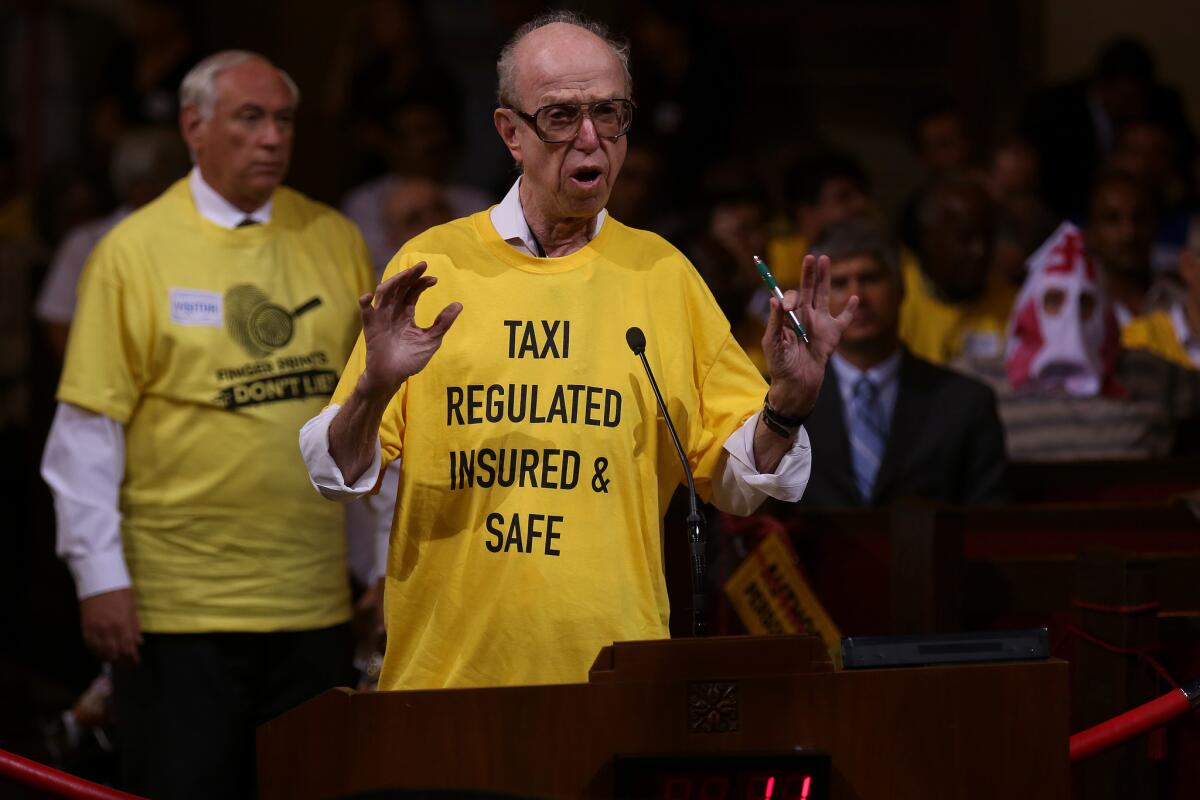Column: Is Uber good or bad for society? The debate continues

David Shapiro, right, founder of United Independent Taxi (drivers) Inc., expresses discontent with Uber at a Los Angeles City Council meeting in August.
- Share via
It’s a fair presumption that as long as there’s an Uber, there will be disagreement over whether the ride-hailing firm is a force for good or bad — or more precisely, good or bad for whom?
In a recent paper, Brishen Rogers of Temple University law school weighs in on the debate. He finds, characteristically, that Uber is good and bad, depending on what you’re measuring. His points, published on the University of Chicago Law Review’s Dialog section, are well worth examining.
Rogers’ paper gets an approving nod from Timothy Taylor, managing editor of the invaluable Journal of Economic Perspectives. Taylor observes that the core debate over Uber is whether it holds a competitive advantage over taxicabs because it cuts corners on regulatory rules, which could be bad for the public interest: “In other words, the newfangled service looks great until you are in a situation with an unsafe and undermaintained vehicle, along with an untrained or underinsured driver.”
On the positive side, Rogers argues that Uber’s success is based not merely on undercutting regulatory rules, but from creating “a far more efficient market for car-hire services.” Non-Uber taxi-hailing is hit or miss, as anyone knows from trying to find a cab in bad weather, at rush hour, in or heading to a bad neighborhood or hailing while black. Phone-dispatched cab services have their own problems, he states: Riders tired of waiting may just go out and hail on the street; phone-assigned drivers may pick up a street fare instead, and so “dispatched cabs may never arrive.”
Uber eliminates the uncertainty. Drivers can’t poach fares or abandon their assignments, and customers get to watch the minute-by-minute progress of their drivers to pick them up via the Uber smartphone app.
As a centralized dispatch service, Uber is relatively easy to regulate — if regulators wish. Its compilation of data on drivers and passengers may even help “ensure safety and root out discrimination against passengers.”
What’s the downside? Rogers argues cogently that some of the concerns about Uber are overblown or premature. “Worries about unsafe Uber cars or unsafe driving are of course legitimate,” he observes, “but the experience of riding in a cab in many cities hardly invites confidence that cab drivers or cabs are much better.”
Uber’s high profile, moreover, could force it to pay more attention to driver qualifications and safety, as “consumers now learn of its every misstep.” He adds: “Any rash of accidents will lead quickly to public ire ... or will create an opening for Uber’s competitors.”
As for fears that Uber eventually will monopolize the transportation market, Rogers acknowledges that that’s probably the firm’s goal, but it’s a little early to concede its triumph, since its app — the core of its business model — is “easy to replicate” and Uber already faces competition from firms such as Lyft, and indeed from traditional taxi owners experimenting with apps of their own. Customers and drivers don’t face significant obstacles in switching to other services.
“Uber may become the Myspace or Netscape of ride-sharing,” he writes. “That is, a pioneer that could not maintain its market position.”
The real risk created by Uber is in the field of labor standards, Rogers contends: “Early signs are not encouraging for workers.” The company leaves drivers to cover their own gas, maintenance and insurance costs, and is not above manipulating fares or the supply of new drivers for its own benefit and arguably the disadvantage of incumbent drivers.
That’s why Uber has faced protests by drivers, some attempts at organizing and a distinct pushback from labor regulators, notably in California. The threat is that drivers will be judged to be Uber employees, changing the balance of costs and Uber’s business model significantly.
It’s unclear how the courts will ultimately line up on the labor issue, Rogers acknowledges, though he’s skeptical that many will agree that the drivers are employees. He doesn’t think drivers are a sufficiently cohesive population to succeed in collective action, either. He observes, however, that since some Uber competitors are offering drivers better terms, such as Gett, drivers may already have more bargaining power than they think.
Looking further ahead, Rogers ponders whether the decline in low-wage work — drivers, supermarket clerks, fast-food servers — isn’t inevitable and even a good thing in the long run. “New technologies like Uber could reduce society’s need for work that is deadening to the human spirit,” he writes. What society isn’t prepared for is managing the change, which could impoverish millions.
Uber’s winner-take-all behavior could make it a target of public mistrust, Rogers says. “The company’s name clearly evinces Nietzsche’s vision of a new morality and a new class dedicated to human excellence,” he says. “But in Uber executives’ hands, that ideal has become little more than a defense of privilege.” It’s up to lawmakers, he concludes, to make sure that Uber’s distinctly nondemocratic corporate values don’t become society’s own.
Keep up to date with the Economy Hub. Follow @hiltzikm on Twitter, see our Facebook page, or email michael.hiltzik@latimes.com.
MORE FROM MICHAEL HILTZIK
Watch a conservative try to show that the working class has done great
Why T-Mobile’s new ‘free’ data plan is bad for the Internet -- and worse for you
Identity-protection firm LifeLock is still in trouble with the FTC — but for what?







